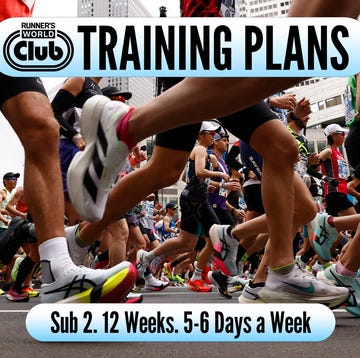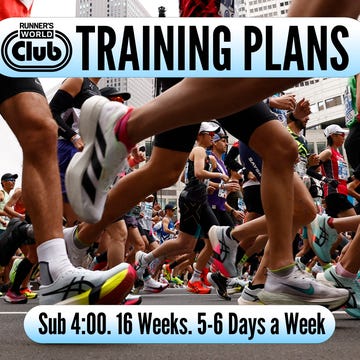A 4:15 marathon is approximately 9:30 per mile. To break 4:15, you should eventually be capable of a sub-1:55half-marathon (8:45 per mile) and sub-55:00 10K (8:20 per mile). Right now, you should be running at least 20 miles per week and you should be able to run for at least an hour non-stop.
Our sub-4:15 marathon plan, encompassing three-four runs per week and this plan will introduce you to structured training and different types of interval sessions included in the plan are explained below.
Rest days: Rest days are an important part of your recovery and adaptation. Respect them and use them as a chance to reflect on your sleep and nutrition. Find some calm space and time to wind down to lower your stress levels and have some time away from your smartphone.
What everyone's reading
Easy runs: Easy, conversational paced running forms the backbone of endurance for events from middle distance up to ultramarathons. Running at a relaxed, easy, conversational pace helps to improve your ability to burn stored fats, improves capillarisation and mitochondria density while also allowing you to increase your training volumes in a sustainable way. While we have suggested a guideline pace how it feels is probably even more important. You should be able to hold a comfortable conversation and breathe easily. If you run to heart rate these runs might be between 60-75% of your maximum heart rate depending on the individual. You can replace some of these easy runs with cardiovascular cross-training sessions of a similar volume and intensity on a bike, rowing machine, elliptical trainer or swimming or aqua jogging. This is a particularly good idea if you are injury prone because it reduces the impact on your muscles and joints whilst still working your heart and lungs.
Interval sessions: Interval sessions involve a series of short repetitions of running typically between 30 seconds and 5-6 minutes with either static rest periods or a very easy jog recovery. Interval training is designed to get you breaking out of your comfort zone and challenging your body to work harder or faster, building fitness and callusing your mind ready for race day.
Fartlek: Fartlek training is similar to interval training, but differs in that the recovery periods are run at an easy or even steady intensity rather than being static rests. Often fartlek sessions will have a more relaxed structure and include a mix of different paces in one session. They can be an effective way of varying your paces whilst maintaining a focus on continuous running and building endurance.
Lactate threshold sessions: These sessions are designed to allow you to sustain higher intensity paces for longer. They can include a mix of longer intervals between 3-15 minutes or they can be run as continuous efforts between 10-40 minutes in length. They are run at a strong, but just about sustainable, intensity typically a pace you could hold for 60-70 minutes in a race.
Progression run: Progression runs are a great way to start to work quality running into your week without getting too worked up about structure. They are good for getting you used to building intensity as you would in a race, and can be an effective way of introducing more threshold running or race specific paces into your training week.
Long runs: Long runs are a key run in your training plan. They are an essential building block for endurance and not only have a wide range of positive effects on your cardiovascular system, but also condition your muscles and bones and help improve your running economy. Some long runs will be run at a fully easy intensity but sometimes you may be asked to run at a stronger pace or even include some blocks of race pace running depending on what you are training for.
Strides: 'Strides' are a good way to get used to running faster and developing speed without the physical and psychological demands of full sprinting. They involve running short efforts normally between 60-100m where the focus is on fast relaxed speed and running with good form. In the plan, we include strides as part of our warm-up before interval training to help you prepare for the sustained faster running in the main session. You may also see strides included after easy runs on occasions to help promote a feeling of speed and zip even on low intensity days. For more on how to perform them correctly, hit the link here.
Strength and conditioning sessions: Strength and conditioning sessions are an important complement to your running. By building a greater number and size of muscle fibres they can help you sustain paces for longer, improve your running economy and they may play a role in injury prevention. We have written a number of common sense body weight plans, but feel free to replace these with gym based strength training or classes e.g. Pilates.
This and all other training plans are part of Runner's World Club, where members can get full access to over 60 plans, covering all distances and time goals - Click here to find out more and to join













